DPU-550 Construction
Step 3. Remove the PIC Processor
There are probably many techniques one could use to remove the PIC processor but I am going to show the one that I think is the easiest and has the lowest risk for damaging the DRO-350 PCB. The only drawback is that it will destroy the PIC processor, or IC socket if you used one instead of soldering the PIC. If you want to preserve the PIC processor and know how to desolder ICs, then by all means go for it. We'll stick to the easy method here.
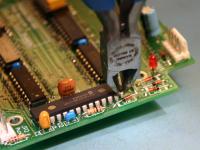
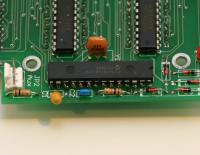 The first step is to clip the PIC pins as close as possible to the body of the PIC processor. You will need decent pair of diagonal cutters (a.k.a "dikes") that have reasonably sharp tips. It is best to start at one end and carefully work your way down the row. Depending on your cutters you can either approach the pin straight down from the top or you can angle the cutters toward the open side of the pin. Either way, snip the pin and then carefully bend it away from the body. Repeat with the rest of the pins and discard the PIC body. You might find that the removal of the ceramic resonator at position Y1 will give you easier access to the PIC. It can be removed simply by snipping the three pins at its base.
The first step is to clip the PIC pins as close as possible to the body of the PIC processor. You will need decent pair of diagonal cutters (a.k.a "dikes") that have reasonably sharp tips. It is best to start at one end and carefully work your way down the row. Depending on your cutters you can either approach the pin straight down from the top or you can angle the cutters toward the open side of the pin. Either way, snip the pin and then carefully bend it away from the body. Repeat with the rest of the pins and discard the PIC body. You might find that the removal of the ceramic resonator at position Y1 will give you easier access to the PIC. It can be removed simply by snipping the three pins at its base.
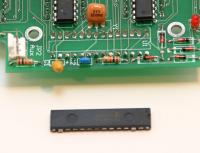 If you mounted your PIC in an IC socket, then you can remove the PIC and save it for another project. To remove the IC socket, you can cut the plastic frame that is between each pin and proceed with the next step.
If you mounted your PIC in an IC socket, then you can remove the PIC and save it for another project. To remove the IC socket, you can cut the plastic frame that is between each pin and proceed with the next step.
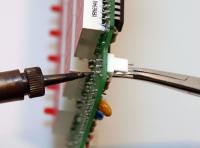 Next, we need to desolder the individual PIC pins. Set the PCB on its side. With one hand, grab the pin with needle-nose pliers and use your other hand to apply heat to that pin from the opposite side. The pin should easily pull out if you do it right. Don't pull hard because you can lift the PCB pads up and then we would have some PCB repair work to do. Repeat this technique for all of the PIC pins.
Next, we need to desolder the individual PIC pins. Set the PCB on its side. With one hand, grab the pin with needle-nose pliers and use your other hand to apply heat to that pin from the opposite side. The pin should easily pull out if you do it right. Don't pull hard because you can lift the PCB pads up and then we would have some PCB repair work to do. Repeat this technique for all of the PIC pins.
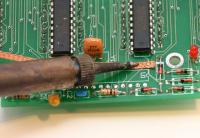
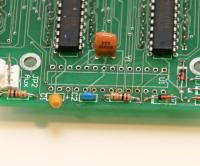 The last step is to clean up the pads with solder wick. Place the solder wick on a pad and apply heat and light pressure for a few seconds. You should see the leftover solder suck right up into the solder wick as well as receive a small blast of noxious fumes from the flux in the solder wick. Repeat this for all of the pins and visually inspect the pins to make sure no leftover solder is still in the pads. You may need to repeat the process from the other side if there is solder deep in the hole. Make sure to get the holes clean or the next step will be more difficult. If there is some stubborn solder that won't come out, then you can fray the end of the solder wick and thred it into the hole. Alternatively, if you have a solder sucker, then you can apply heat and suck the last remaining solder up. Another technique is to heat the pad with the iron and quickly blow through the hole with a strong breath. However you do it, just get those pads clean.
The last step is to clean up the pads with solder wick. Place the solder wick on a pad and apply heat and light pressure for a few seconds. You should see the leftover solder suck right up into the solder wick as well as receive a small blast of noxious fumes from the flux in the solder wick. Repeat this for all of the pins and visually inspect the pins to make sure no leftover solder is still in the pads. You may need to repeat the process from the other side if there is solder deep in the hole. Make sure to get the holes clean or the next step will be more difficult. If there is some stubborn solder that won't come out, then you can fray the end of the solder wick and thred it into the hole. Alternatively, if you have a solder sucker, then you can apply heat and suck the last remaining solder up. Another technique is to heat the pad with the iron and quickly blow through the hole with a strong breath. However you do it, just get those pads clean.
